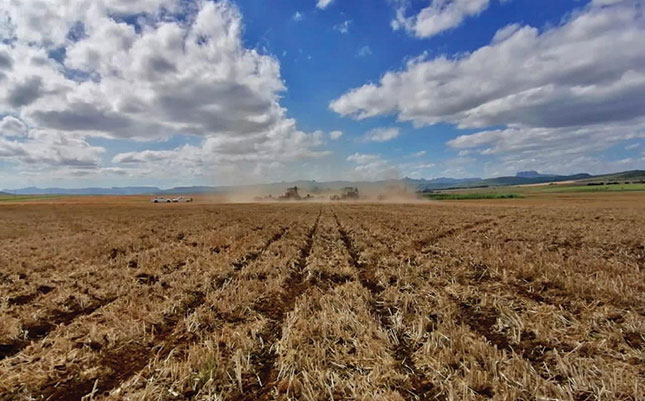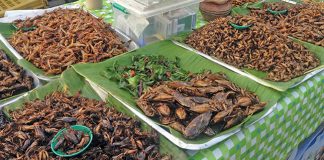
Photo: Tyson Zunckel
Danie Bester farms on Rietbult near Balfour in Mpumalanga, and his scientific approach to production is well known in the industry at large. He does a great deal of research on soil health, and says that his entire farming operation is based on the improvement of his soil. “My whole operation changed the day I decided to focus on soil health, and I haven’t looked back since,” he explains.
Bester also stresses that South African farmers are actually farming water: “We must manage our available water resources effectively and optimally. For plants to grow, they need moisture in the soil, and for optimal moisture retention, we need healthy soil. Healthy soil is full of nutrients, and this forms the base of my production system.
“Sustainability and profitability are interlinked; you can’t have one without the other.
However, both are dependent on a holistic approach to soil health and productivity.”
He says that proper water and soil management are two of the most important elements for carrying a farmer through difficult seasons. According to him, 80% of his yield is determined by soil condition.
“Productivity is inherent in the soil. The availability and uptake of plant nutrients, as well as soil practices and moisture, are the factors that determine your yield and profitability. A healthy soil biology will unlock your soil’s potential, as it’s only through biological actions that the nutrients become available to plants in a usable form.
“The remaining 20% of my yield is determined by cultivar choice, my implements, and planter precision.”
The bigger picture
Bester says that soil management is not a standalone system, and should be incorporated into the overall farming operation. He follows no-till methods (also fundamental to regenerative agriculture) to optimise soil moisture retention, reduce compaction, and increase beneficial soil microbes.
No-till production has had a positive effect on Bester’s crops due to the resultant cooler soils, better moisture retention, and improved root development combined with more biological activity. However, he points out that there is more to soil health than just conservation tillage. Crop rotation, cover cropping and precision farming are all central to his approach.
While he focuses on maize and soya bean production, he plants winter wheat as a cover crop between rotations. “Each cover crop provides a solution to a specific problem. It’s therefore crucial to know what the soil issue is so you know which solution to turn to.”
Precision agriculture
He takes soil and leaf samples throughout the year, submitting them for analysis to determine the levels and availability of plant nutrients. He also measures the yield of each land on an annual basis to determine the effects of any adjustments he might have made based on the analysis.
Bester stresses that precision agriculture is valuable, but that it involves a lot more than just planting neat rows. He says the information he gathers during and after each season is used to decide on variable-rate planting and chemical applications.
Correcting the pH level of the soil forms part of his soil-improvement actions, and sometimes means that he has to apply lime or other elements as indicated by the soil analysis. Micronutrients in the soil enable plants to use sunlight more effectively. They activate enzymes involved in respiration and nitrogen metabolism so that, via photosynthesis, the plants are able to convert sunlight and carbon into sugars.
“By comparing multiple years’ data with the results of the soil and leaf analyses, I can see what has changed and determine why it has done so. I use the data to ascertain, on a practical level, whether water stress, [soil] compaction or nutrient deficiency caused poor root development, or if any other factor led to differences in yield.
“I also use the information to calibrate implements and adjust tillage practices. If a problem has been identified, corrective measures can be carried out. This is the crux of maintaining soil health and farming sustainably.”
Bester cautions, however, that managing soil health is not a once-off exercise: “Managing your soil is a continuous process that requires dedication. You need to constantly evaluate the situation and make adjustments according to the available information.”
He also advises farmers to make contact with one another to discuss problems and come up with possible solutions.
“Ask questions and investigate yield results. There’s always a reason why your yield is up or down, and most often the reason can be found in the soil,” he concludes.
Restoring the soil
The Zunckel family farms maize, soya bean and wheat near Bergville in KwaZulu-Natal and Warden in the eastern Free State. Livestock is also an important part of its operations.
Zunckel Farms’ philosophy is that a healthy agricultural system is one that supports all forms of life, and one of the pillars of its operations is the restoration of carbon and organic matter in the soil.
Tyson Zunckel, who farms with his father and brother, emphasises that leaving your own footprints on your lands is crucial to achieving success, especially when it comes to soil health. “Although other people can provide recommendations, you have to see for yourself what is happening in your fields.”
He points out that soil bacteria and fungi work in tandem to make minerals and nutrients in the soil available to the plants, enabling them to take up the nutrients via their root systems.
“When we restored the health of our soil, the result was healthier plants that could draw more carbon from the atmosphere into the soil during photosynthesis.
“We believe in minimum soil disturbance and minimal use of chemicals, and focus on regenerating the soil. We base our farming practices on what is best for the soil and its health.”
They introduced diversified crop rotation, and cover crops such as oats and radishes now form part of their permanent rotation. In this way, they are able to achieve maximum soil cover via either living plants or plant residues, and always have a living root system in the soil.
“Cover crops play a pivotal role in combating nematodes, and help to improve overall soil health,” explains Zunckel. “We plant our cover crops immediately after our soya bean crops. Cattle also graze on the cover crops and maize residue.
“Plants’ root systems, and the microbes and bacteria living among these roots, all make a significant contribution towards improving the health and structure of the soil.”
The proof is in the pudding
According to him, their efforts have paid off: “We can see a difference in our soil; it’s darker, softer and contains more organic matter. [The analysis of] samples also shows that we’ve increased the carbon in the soil over the past 12 years.
“Our practices have also helped to reduce soil erosion, improve water infiltration, and increase moisture retention, which has led to sustainable production and higher yields over time. We’ve also seen an increase in beneficial insects, especially bees, as well as birds and antelope on the farm.”
They apply lime and nutrients to the surface of the soil according to the results of the grid sampling they perform on a four-year rotation. Samples are taken from 1ha and 2ha grids of top- and subsoil respectively. The results determine the variable-rate planting prescriptions for each land.
Zunckel says that because of skyrocketing fertiliser prices, they re-evaluated their practices over the past few years and now use more cattle and chicken manure than fertiliser.
He adds that they also follow a four-year rotation system when applying manure. They broadcast 10t of manure onto the soil that they have analysed during a particular season.
“We achieve the same yield results, but feel that we add extra elements to the soil in this manner. When we come back to that particular section of the farm after four years, we analyse the soil again to determine what it needs.”
The importance of planning
Zunckel emphasises that along with soil analysis, proper and detailed planning are vital.
“When planning before each season, you need to look at the condition of your soil and weather predictions before you make any final decisions.
“Our integrated farm management strategy covers soil health, water management, weed control, pest and disease control with seed treatments, and proper crop rotation.”
He says adds that a farmer needs to change cultivation practices before converting to a minimum- or no-till system.
“We adjusted our mindset and invested in cultivation equipment over time. It takes time to put organic matter back into the soil and for mulch to build up, so be patient.
“Although our methods helped to increase our profitability, we were focused on imitating nature and doing what was right for the soil.”
Email Danie Bester at [email protected], or Tyson Zunckel at [email protected].












